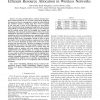Free Online Productivity Tools
i2Speak
i2Symbol
i2OCR
iTex2Img
iWeb2Print
iWeb2Shot
i2Type
iPdf2Split
iPdf2Merge
i2Bopomofo
i2Arabic
i2Style
i2Image
i2PDF
iLatex2Rtf
Sci2ools
TWC
2008
2008
MEERA: Cross-Layer Methodology for Energy Efficient Resource Allocation in Wireless Networks
Abstract-- In many portable devices, wireless network interfaces consume upwards of 30% of scarce system energy. Reducing the transceiver's power consumption to extend the system lifetime has therefore become a design goal. Our work is targated at this goal and is based on the following two observations. First, conventional energy management approaches have focused independently on minimizing the fixed energy cost (by shutdown) and on scalable energy costs (by leveraging, for example, the modulation, code-rate and transmission power). These two energy management approaches present a tradeoff. For example, lower modulation rates and transmission power minimize the variable energy component, but this shortens the sleep duration thereby increasing fixed energy consumption. Second, in order to meet the Quality of Service (QoS) timeliness requirements for multiple users, we need to determine to what extent each system in the network may sleep and scale. Therefore, we propose a two-phas...
| Added | 16 Dec 2010 |
| Updated | 16 Dec 2010 |
| Type | Journal |
| Year | 2008 |
| Where | TWC |
| Authors | Sofie Pollin, Rahul Mangharam, Bruno Bougard, Liesbet Van der Perre, Ingrid Moerman, Ragunathan Rajkumar, Francky Catthoor |
Comments (0)

